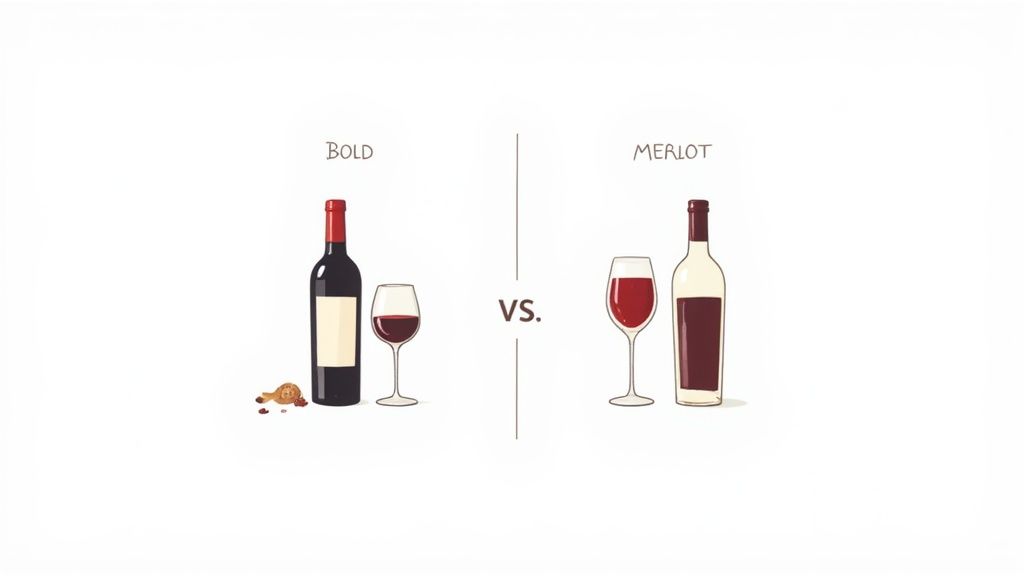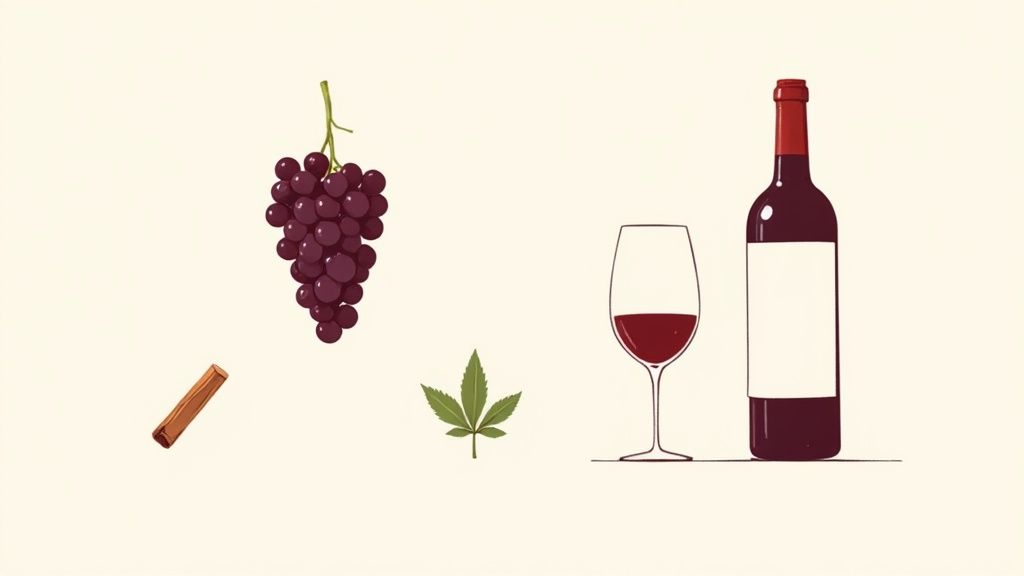Deciding between Cabernet Sauvignon and Merlot really comes down to a simple question: are you in the mood for bold or for soft? Choose Cabernet Sauvignon if you’re after a powerful, structured wine with deep flavours and a texture that stands up to hearty meals. If you’d prefer a smoother, fruit-forward red that’s easy to enjoy on its own or with a variety of foods, then Merlot is your go-to.
Your Guide to Choosing the Right Red
Getting to know the core differences between these two famous reds is the best way to find your favourite. Both grapes trace their roots back to Bordeaux in France and even share a parent (Cabernet Franc), but in the glass, they couldn’t be more different. One brings power and complexity; the other offers a plush, approachable character.

To make things simple, let's put them side-by-side. This table cuts straight to the chase, highlighting what truly defines each wine, from its classic flavours to how it feels in your mouth.
Quick Comparison Cabernet Sauvignon vs Merlot
Use this table for a direct, side-by-side look at the core differences between Cabernet Sauvignon and Merlot.
| Characteristic | Cabernet Sauvignon | Merlot |
|---|---|---|
| Primary Flavours | Blackcurrant, blackberry, cedar, mint | Plum, raspberry, cherry, chocolate |
| Body | Full-bodied | Medium to full-bodied |
| Tannins | High | Medium |
| Acidity | High | Medium |
| Texture | Firm, structured, powerful | Soft, plush, velvety |
| Ideal Food Pairing | Grilled steak, lamb, hearty stews | Roast chicken, pasta, pork loin |
| Ageing Potential | Excellent, often improves with age | Good, typically best within 5-10 years |
This quick look gives you a solid starting point. Cabernet Sauvignon’s robust tannins and acidity make it a brilliant match for rich, fatty foods it cuts through the richness and cleanses the palate perfectly.
On the other hand, Merlot’s softer profile and ripe fruit notes make it a more versatile and forgiving wine. It gets along with a much wider range of dishes and is often a more welcoming choice for those just starting to explore red wines. As we dig a little deeper, you’ll start to see all the subtle details that make each of these grapes so special.
The Profile of Cabernet Sauvignon
Often called the king of red grapes, Cabernet Sauvignon is all about a bold, complex experience. It's the wine that defines many of the world's most famous reds, and its powerful structure is its calling card. Built on high levels of tannin and acidity, it creates a full-bodied texture and a firm, satisfying grip on the palate. This is a wine that commands your attention from the very first sip.

Its signature flavour profile is driven by dark fruits. Think prominent notes of blackcurrant, dark cherry, and blackberry these form the core of its character. But the real magic lies in how these primary fruit flavours are layered with more complex, savoury, and herbal nuances that develop with age and careful winemaking.
Deeper Layers of Flavour
Beyond its fruit-forward nature, Cabernet Sauvignon reveals some intriguing secondary notes that add to its depth. As you explore a glass, you might pick up hints of:
- Cedar and Tobacco: Often a gift from ageing in oak barrels, these aromas lend a classic, refined quality.
- Mint or Eucalyptus: A refreshing lift, particularly common in Australian Cabernet.
- Graphite or Pencil Shavings: A subtle minerality that speaks to its terroir and serious structure.
- Green Bell Pepper: A characteristic note from a compound called pyrazine, which tends to be more noticeable in cooler climates.
This complex profile makes every bottle a unique discovery. Its robust character stems from its origins as an accidental cross between Cabernet Franc and Sauvignon Blanc back in 17th-century Bordeaux. If you're curious about its journey from a French vineyard accident to global royalty, you can learn more about the origins of the Cabernet Sauvignon grape in our detailed guide.
Cabernet Sauvignon is celebrated for its remarkable ability to age. The high tannin content, which creates that drying sensation in your mouth, acts as a natural preservative, allowing the wine to evolve gracefully in the cellar for decades.
A Dominant Force in Australian Wine
Cabernet Sauvignon's popularity isn't just a matter of taste; it's a cornerstone of the Australian wine industry. It is the leading red grape variety in Australia by volume, making up around 11% of the total grape crush. In the 2023–24 season alone, production hit approximately 153,644 tonnes more than double the volume of Merlot. These figures from Wine Australia highlight its sheer dominance in vineyards across the country.
This prevalence means our winemakers have extensive experience with the grape, particularly in regions like McLaren Vale where the warm climate helps ripen its powerful tannins perfectly. The result is a wine that balances rich fruit concentration with the grape's inherent structural integrity, creating a classic expression that is both powerful and seriously age-worthy.
The Character of Merlot
If Cabernet Sauvignon is the bold monarch, Merlot is the smooth diplomat. It’s known for its approachable, often luscious character, offering a softer, more fruit-forward experience that has made it a global favourite. Merlot trades Cab Sauv’s powerful structure for a rounded, velvety texture that feels plush and inviting from the very first sip.

The flavour profile is usually all about ripe red fruits. Think juicy plums, black cherries, and fresh raspberries. These vibrant notes are often layered with hints of cocoa, vanilla, and a touch of fruitcake spice, especially when the wine has spent a bit of time maturing in oak.
Its signature appeal really comes down to texture. Merlot has softer, finer-grained tannins and generally lower acidity than Cabernet Sauvignon, a combination that creates a smoother, less grippy mouthfeel many drinkers find immediately appealing.
An Approachable Flavour Profile
What makes Merlot so easy to love is its beautiful balance. While it can be complex, it rarely hits you with the same tannic intensity as a young Cabernet. This makes it a fantastic starting point for those new to red wine, but also a reliable and versatile choice for seasoned enthusiasts.
Key characteristics to look for include:
- A Softer Finish: The tannins are there, but they feel more silky than abrasive.
- Fruit-Forward Notes: The primary flavours are all about ripe, juicy red and black fruits.
- Subtle Complexity: Notes of chocolate, bay leaf, or vanilla can add layers without overwhelming your palate.
Unlike the often assertive nature of Cabernet Sauvignon, Merlot is celebrated for its ability to be both a standout solo performer and a crucial team player. It’s a vital blending grape in many famous Bordeaux-style wines, adding softness and fruit to balance Cabernet’s structure.
A Key Player in Australia's Vineyards
Merlot has well and truly established its place in the Australian wine landscape. It occupies approximately 6.3% of the country's total wine grape growing area, covering around 8,480 hectares. In a single year, Australian wineries crushed over 111,000 tonnes of Merlot, showing just how significant its role is in the local industry. Regions like Riverland and Riverina are major producers, contributing to a style that is loved both at home and abroad.
This grape’s adaptability allows it to express itself differently depending on the climate. The question of Cabernet Sauvignon or Merlot often comes down to this difference in texture and primary flavours. If you want to dive deeper, our guide on the origins of the Merlot wine grape offers a fascinating look into its journey. It provides a beautiful counterpoint to the powerful Cabernet, showcasing a charm that is all its own.
A Detailed Look at Flavour and Structure
When you're trying to decide between a Cabernet Sauvignon and a Merlot, it really boils down to two things: flavour and, more importantly, structure. Sure, both can show a spectrum of dark and red fruits, but it’s the secondary notes and the way the wine feels in your mouth that create two completely different experiences. Think of it like a finely tailored wool suit versus a luxurious velvet jacket both are top quality, but they have an entirely different feel.
Cabernet Sauvignon is often marked by a subtle, savoury 'green' streak. This isn't a fault; it's a signature part of its identity, coming from compounds called pyrazines. In a well-made Cab, this shows up as attractive notes of mint, eucalyptus, bay leaf, or even a hint of green capsicum, adding a layer of herbal complexity that slices through the rich blackcurrant and cherry fruit.
Merlot, on the other hand, leans into warmer, sweeter spice notes. Instead of that herbal lift, you're much more likely to find hints of fruitcake, cinnamon, clove, and rich chocolate. These flavours wrap around its naturally plush, ripe plum and raspberry core, creating a profile that feels generous and comforting right out of the gate.
It's All About Tannin and Texture
Beyond flavour, the biggest point of difference is how each wine feels. This comes down to tannin the natural compounds that give you that drying sensation on your palate.
Cabernet Sauvignon is famous for being high in tannins. This gives it a firm, structured, and sometimes powerfully grippy mouthfeel, especially when it’s young. That tannic backbone is exactly what gives the wine its remarkable potential for ageing. It’s also why it’s a brilliant match for fatty foods like a good steak; the tannins latch onto the proteins, cleaning your palate with every sip.
Merlot’s tannins are typically softer and more fine-grained. The result is a wine that feels much smoother, rounder, and more velvety on the palate. The texture is often described as plush or silky, making it far more approachable from the moment the cork is pulled.
The structural difference is the key takeaway: Cabernet Sauvignon builds a strong, architectural frame in your mouth with its tannins and acidity. Merlot drapes your palate in a soft, velvety texture. One is about power and longevity; the other is all about lushness and immediate pleasure.
Acidity and Drinkability
Acidity is the final piece of this structural puzzle. Cabernet Sauvignon generally has higher acidity, which brings a refreshing quality to the wine and adds to its age-worthiness. This brightness is crucial for balancing its powerful fruit and tannins, keeping the wine from ever feeling heavy or sluggish.
Merlot's acidity is usually more moderate, which contributes to its rounder, softer profile. This makes it an incredibly versatile and easy drinking wine that doesn't necessarily need food to be enjoyed. While top-tier Merlots can certainly age gracefully, most are made to be enjoyed in their youth, offering a smooth, satisfying experience without years in the cellar. This immediate drinkability is a massive part of its global appeal.
Pairing Wine with the Right Dish
Stuck on whether to open a Cabernet Sauvignon or a Merlot? The answer is often sitting right on your dinner plate. Getting the pairing right isn't just about matching flavours; it's about creating a moment where both the food and the wine sing. The golden rule is simple: match the wine's body and intensity to the richness of the dish.

With its commanding structure and high tannins, Cabernet Sauvignon is practically begging for rich, fatty, and powerfully flavoured foods. Yes, grilled steak is the classic go-to, but its real power shines when you think beyond the obvious.
Perfect Pairings for Cabernet Sauvignon
Think of a Cabernet’s tannins as a secret weapon for your palate. They latch onto proteins and fats, slicing through richness and readying your tastebuds for the next glorious bite. This is why it’s a brilliant match for:
- Braised Lamb Shanks: The wine’s dark fruit and herbal notes are a beautiful counterpoint to the slow-cooked, savoury meat.
- Rich Mushroom Risotto: The earthy mushrooms and creamy parmesan need the wine's structure and acidity to cut through the decadence.
- Aged Hard Cheeses: A bold cheddar or a sharp pecorino can stand shoulder-to-shoulder with the wine's intensity, creating a real flavour explosion.
The rule of thumb for Cabernet Sauvignon is simple: go bold. Its assertive character needs a dish that won't get lost in the background. The more flavour and fat on the plate, the better that bottle will taste.
Versatile Matches for Merlot
Merlot, with its softer tannins and plush, fruity profile, is a much more adaptable player at the dinner table. It shines with dishes that are flavourful but not overwhelmingly heavy, filling that gap where a Cab might just be too much.
If you're building a platter, exploring specific charcuterie and wine pairings can really elevate the experience, and Merlot’s gentle nature makes it a fantastic choice for a mixed board.
It also works beautifully with a whole host of main courses.
- Roast Chicken or Pork Loin: Its juicy red fruit flavours complement roasted white meats without steamrolling them.
- Pasta with Tomato-Based Sauces: A classic bolognese or marinara finds a perfect partner in Merlot, whose soft texture harmonises with the sauce’s tangy notes.
- Lentil Shepherd's Pie: This is a fantastic vegetarian option, where the earthy lentils and rich gravy are lifted by the wine's supple fruit.
At the end of the day, Merlot’s approachable, easy going nature makes it a safe and delicious bet for group dinners and menus with a bit of everything.
How Australian Regions Shape Each Wine
Just like an accent tells you where someone’s from, the place a grape is grown profoundly shapes a wine's final character. Australia's incredibly diverse landscapes create distinctly different expressions of Cabernet Sauvignon and Merlot. This means a bottle from one area can taste completely different from another, and the choice between them often comes down to the style you prefer a style heavily influenced by its home.
This regional thumbprint, or terroir, is the magic combination of soil, climate, and topography. Think of the famous ‘terra rossa’ soil of Coonawarra a vibrant red clay over limestone that’s legendary for producing Cabernet Sauvignon with incredible structure, deep blackcurrant notes, and a signature hint of mint. It's terroir in action.
Climate and Character
Warmer regions, like our home turf in McLaren Vale, are known for producing bold, fruit-forward styles. The generous sunshine lets the grapes ripen fully, creating wines with big, juicy flavours, softer tannins, and a rich, powerful profile that's immediately appealing.
Cooler climates, on the other hand, tend to produce more restrained and elegant wines. The grapes ripen slowly, holding onto their acidity and developing more nuanced, savoury characteristics along the way.
The key difference really comes down to ripeness and structure. A McLaren Vale Cabernet might burst with jammy dark fruit, while one from a cooler area could show more herbal notes and a tighter tannic frame, begging for more time in the cellar to soften up.
Australia’s most celebrated regions for these grapes include Margaret River in Western Australia, alongside Coonawarra and McLaren Vale in South Australia. Margaret River, in particular, is renowned for its premium quality Cabernet and Merlot, often drawing favourable comparisons to classic Bordeaux blends thanks to its unique maritime climate.
Knowing these differences empowers you to pick a bottle based not just on the grape, but on its origin. To get a better sense of how it all works together, check out our guide to understanding Australian wine regions and their unique terroir. This knowledge helps you anticipate the style in the bottle and find the perfect wine for your palate.
Your Questions, Answered
Still tossing up between a Cabernet Sauvignon and a Merlot? It's a classic head-to-head, so we've tackled the most common questions to help you choose the right bottle with confidence.
Which Wine Is Better for Ageing, Cabernet Sauvignon or Merlot?
When it comes to cellaring, Cabernet Sauvignon is almost always the superior choice. Its powerful structure built on high tannins and robust acidity—acts as a natural preservative. This backbone allows the wine to soften and evolve beautifully over many years, developing incredible secondary notes of leather, tobacco, and savoury earth.
While a few top-shelf Merlots from exceptional producers can certainly age gracefully for a decade or more, the vast majority are crafted to be enjoyed in their youth. They're at their plush, fruity best within the first few years.
The decision to age a wine really comes down to its structure. Cabernet Sauvignon is built for the long haul, while most Merlots offer their peak pleasure much sooner.
Is Merlot Always Sweeter than Cabernet Sauvignon?
No, and this is a classic misconception. Both wines are typically fermented to be completely dry, which means there's little to no residual sugar left. That feeling of "sweetness" in a Merlot comes from its flavour profile, not actual sugar.
Merlot's hallmark notes of juicy plums and sweet cherries, combined with its softer, rounder texture, can trick our brains into perceiving sweetness. Cabernet Sauvignon, on the other hand, usually presents a more savoury, structured profile with firm tannins, which doesn't register as "sweet" on the palate in the same way.
Which Wine Is a Safer Choice for a Dinner Party?
If you're ever in doubt, Merlot is often the safer, more crowd-pleasing option for a dinner party. This is especially true if you're not sure about your guests' wine preferences or what's on the menu. Its approachable, fruit-forward character and softer tannins make it incredibly versatile.
Merlot pairs wonderfully with a whole range of dishes, from roast chicken to pasta, and it’s less likely to overpower lighter meals. Plus, its smooth profile makes it a great wine to just sip and enjoy on its own, making it a flexible and welcoming choice for any gathering.
Ready to explore the best of McLaren Vale? At McLaren Vale Cellars, we've handpicked a stunning selection of both powerful Cabernet Sauvignon and plush Merlot from the region's top producers. Discover your next favourite red today by browsing our collection at https://www.mclarenvalecellars.com.




Comments (0)
There are no comments for this article. Be the first one to leave a message!